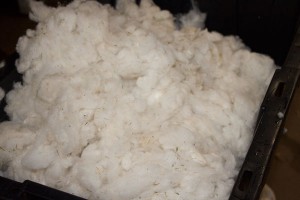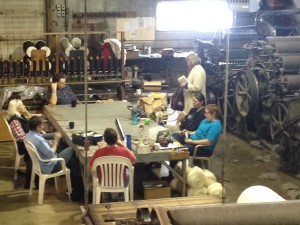Care for people and the environment is always on our minds at Custom Woolen Mills - it is something we are very passionate about as the foundation of our business. You would be hard pressed to convince us of a more appropriate textile than locally grown and manufactured woolens when concern for function, social impact, and environmental impact are considered. However, as sheep shearing, wool wearing fanatics, it's not us who need convincing! In a world filled with a dizzying abundance of new "green" products, "ethical trade" certifications, and aggressive advertising, it can be difficult for folks outside of the textile industry to discern what makes one product more sustainable than the next. Luckily, there are ways to navigate it all. One way that many people are familiar with is to use the R's of sustainability - rethink, refuse, reduce, reuse, repair, recycle, and rot - as a framework for making sustainable choices in a consumer culture. Over several blogs this year, we're going to break those down and share with you how that framework applies to locally-produced woolen products and the broader textile industry.
The first R of sustainability is Rethink; this is about being critical of a product before you buy - no impulse buying! Some good questions to ask yourself in this step are: how are the raw materials obtained for this product? Have they been ethically obtained? Are they renewable? Do they have high impact processing requirements? What are the working conditions of the people who make this product? How long will this product last me? How will I dispose of it when I am finished with it?
The second R is Refuse, which basically encourages you to refuse to purchase products that don't meet the standards of your Rethink process - causing change by voting with your dollar.
Wool - The Raw Material
As a raw material, wool is a natural fibre obtained from sheep. Sheep eat grass and grow wool - they are like little carbon converters that need to be shorn every year and, as long as there are sheep in the world, there will be wool. Here at the mill, we buy the wool clip year after year from the same farms because, year after year, their sheep are growing more wool. This makes wool a readily available renewable resource. Additionally, if the sheep growing the wool are managed conscientiously, grazing sheep (and therefore growing wool) can have a healthful impact on park and grassland ecosystems, making wool not only a renewable, but regenerative resource. For example, the City of Fort Saskatchewan, Alberta, uses sheep as a low impact method for park turf management, allowing them to keep the parks trim, weed free, and fertilized without needing additional inputs. There are a wide range of animal husbandry practices around the world, and so some sheep are raised under more ethical conditions and with better environment practices than others, which is why we encourage people to buy local wool first. When you buy local wool, you can ask directly about those practices (check out our blog The Canadian Wool We Use and How it is Grown for more details about Custom Woolen Mills wool) and ensure your dollars are supporting practices that you can feel good about. In contrast, most synthetic fibres (such as Polar Fleece) are made from limited petrochemical resources, which are non-renewable and require considerable environmental destruction to be extracted.
Wool Processing
When it comes to processing requirements, once a fibre is ready for carding, they are fundamentally the same for all textiles whether animal fibre based, plant based, or synthetic. Where one fibre type might stand out as more sustainable than another is in the steps required to get it to the carding stage. Of all the textiles, wool has some of the fewest requirements. If you want, you can hand-spin wool right from the raw fleece shorn from the sheep; this is called spinning in the grease, or grease wool, and traditional water-resistant fishing sweaters were often made this way. This minimal processing requirement (shear it off the sheep) is unique and quite remarkable, but while there are some exceptional textile artists creating work from raw wool, realistically, most wool is processed in a mill.
To process wool in a mill it must first be transported there. Transportation can have a big impact on the sustainability of a product. In Canada, we are fortunate to have a few of the last remaining "vertical mills" in North America - MacAusland's Woolen Mills in P.E.I., Briggs and Little Woolen Mills in New Brunswick, and us here at Custom Woolen Mills. "Vertical mills" are mills that do all the processing, from raw fibre to finished consumer product, at one location, thereby greatly reducing the transportation requirements of the product and the carbon resources require to make it. You can take an online tour of our mill to see how it is done. In large-scale textile production it is more common for there to be several mills involved, each specializing in a different process (this is universal to all types of textiles including plant based and synthetic fibres), so raw fibre could be harvested in Australia, transported to New Zealand for washing, then to different mills in India for spinning, knitting, and sewing. This is why knowing both where your product is grown and where it is processed can have a big impact on the "rethink" part of your decision making. Unfortunately, knowing both these things is extremely difficult. Labelling laws do not require any declaration of origin beyond the final assembly point of a product, so unless the manufacturer offers that information up, it will take some hard research to figure out.
Once at the mill, as a minimum, raw wool needs to be scoured (a technical term for washed) before it is ready for carding and spinning. At Custom Woolen Mills we practice minimal processing and so use only a mild plant-based biodegradable detergent and then rinse with water - beyond that, our wool is ready for carding. Unfortunately, very few other mills practice minimal processing, instead opting to also bleach, carbonize, and "super wash" treat their wool in a effort to appeal to consumer demand for bright-white, vegetation-free, shrink-proof textiles. These practices are unnecessary and, we feel, unsustainable. However, even after bleaching, carbonizing, and super washing, when compared to other main-stream eco-textiles, wool is still in the running for top choice. There are many plant-based natural fibres, such as hemp and bamboo, that are considered "green" textile options because they are renewable, however, they require extensive mechanical and chemical processing to break the cellulose fibre down into a usable form from which they can then be carded and spun.
Labour Conditions
People are increasingly aware of the poor labour conditions under which many textiles are made. Textile production is labour intensive and, in order for companies to provide cheap prices but still make large profits, many textiles are made where labour can be exploited. It is a huge global problem. One way to combat this is by purchasing textiles that you can trace to ethically run businesses where workers and crafts people are treated with basic human respect. We think the easiest way to ensure this is by purchasing products manufactured domestically or in countries with employment regulations similar to our own. The Canadian provincial governments have very robust systems for ensuring that employers meet the basic workplace standards we all expect - a safe working environment, a decent wage, reasonable working hours, holidays. Further to that, there are many avenues that individuals can take to combat employers that do not meet those standards (complaints to regulatory bodies, media exposure, and legal action). Combined, these things allow us to purchase locally made products with ease of mind, but identifying those products can be challenging. Fortunately, there are an increasing number of websites, such as snowberry and buycanadianfirst, designed to help consumers find Canadian made brands. There are also an increasing number of textile and fashion companies, such as the new start-up Alberta Apparel, that are committing to using Canadian manufacturers for their products. Finally, there are some stores, such as North American Quality Purveyors in Calgary, that specialize in bringing these brands together under one roof.
When purchasing products that are manufactured in countries with unknown working conditions (or a history of allowing worker exploitation and slave labour), we must either trust a company's declaration that they insist on proper worker treatment or rely on third-party certifications such as "Fair Trade". Both of these options can be problematic because of the way one textile product, such as a shirt, can go through many different companies and facilities from raw fibre to finished garment. It is fine for a company to say "we treat our seamstresses ethically", but can they say the same for the workers at the weaving company from which they purchased the fabric, and down the line to the company that spun the thread, and then the farm that grew the cotton? This is extremely difficult and rare for a company to do - only small companies like Maiwa, in Vancouver, come to mind - so much so that third-party certifying bodies don't require it. For example, Pategonia has a "Fair Trade" line of clothing, but only the last production step of cutting and sewing is regulated under this certification. We feel this makes the "Fair Trade" declaration a bit mis-leading; they get the marketing benefit of a certification that implies their product is different or better than others, but really a comparable Canadian company, such as Stanfields in Nova Scotia (maker of amazing wool and wool-blend base layer clothing), is easily providing a better guarantee of fair worker treatment by knitting the fabric as well as cutting and sewing all their product here in Canada.
Wool - The End Product
Thinking about a product's useful lifetime and disposal is the last part of the Rethink process. Will this product be durable and long-lasting? Can it be repaired, reused, up-cycled, or recycled? Lastly, at the end of the day, can it be composted or "rotted" rather than land-filled? With wool, the simply answer to all of these questions is yes! We'll go into more detail about these things in parts 2 through 4 of this blog series - Reduce and Reuse, Repair and Recycle, and Rot.
Special thanks to MacAusland's, Stanfields, and Canadian Co-operative Wool Growers for answering some of our questions in researching this blog.














